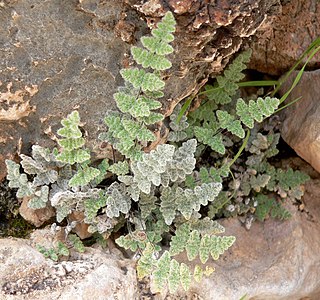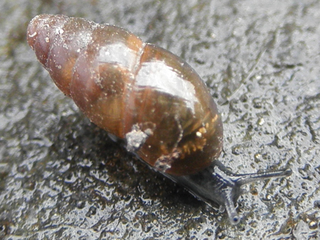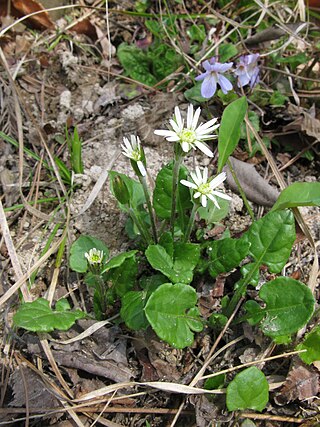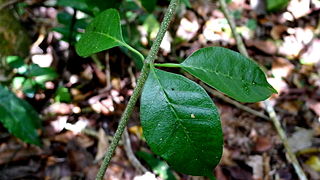
Cheilanthes, commonly known as lip ferns, is a genus of about 180 species of rock-dwelling ferns with a cosmopolitan distribution in warm, dry, rocky regions, often growing in small crevices high up on cliffs. Most are small, sturdy and evergreen. The leaves, often densely covered in trichomes, spring directly from the rootstocks. Many of them are desert ferns, curling up during dry times and reviving with the coming of moisture. At the ends of veins sporangia, or spore-bearing structures, are protected by leaf margins, which curl over them.

Planaria is a genus of planarians in the family Planariidae. Due to its excellent ability to regenerate, species of Planaria has also been used as model organisms in regeneration studies. When an individual is cut into pieces, each piece has the ability to regenerate into a fully formed individual. When decapitated, they retain their memories.

Marchantiales is an order of thallose liverworts that includes species like Marchantia polymorpha, a widespread plant often found beside rivers, and Lunularia cruciata, a common and often troublesome weed in moist, temperate gardens and greenhouses.

Limax is a genus of air-breathing land slugs in the terrestrial pulmonate gastropod mollusk family Limacidae.

Peckoltia is a genus of small South American armored suckermouth catfishes. Many of these fish are popular aquarium fish.

Cochlicopa, whose species are known as pillar snails, is a genus of small air-breathing land snails, terrestrial pulmonate gastropod mollusks in the family Cochlicopidae.

Arius is a genus of catfishes of the family Ariidae. The genus Arius is distributed in brackish and fresh waters of Eastern Africa and south to Southeast Asia.

Gustav Kunze was a German professor of zoology, an entomologist and botanist with an interest mainly in ferns and orchids.

Donacia is a large genus of aquatic leaf beetles in the subfamily Donaciinae. Like other members of that subfamily, the beetles have long antennae. They are active and able to fly. Larvae feed on submerged portions of aquatic plants, such as water lilies, and breathe oxygen from plant vessels. Adults live on surface parts of the same plants.

Leibnitzia (sunbonnets) is a genus of Asian and North American flowering plants in the family Asteraceae.

Pleurobrachia is a common genus of Ctenophora(an exclusively marine phylum). Along with the genus Hormiphora, it generally has the common name sea gooseberry. It contains the following species:

Thiara is a genus of freshwater snails, aquatic gastropod mollusks in the subfamily Thiarinae of the family Thiaridae.

Condylocarpon is a genus of flowering plants in the family Apocynaceae first described as a genus in 1822. It is primarily native to South America, though found also in Trinidad & Tobago and Nicaragua.
Philipp Wilbrand Jacob Müller was a German entomologist who specialised in Coleoptera.

Polypodium is a genus of ferns in the family Polypodiaceae, subfamily Polypodioideae, according to the Pteridophyte Phylogeny Group classification of 2016 (PPG I). The genus is widely distributed throughout the world, with the highest species diversity in the tropics. The name is derived from Ancient Greek poly (πολύ) "many" + podion (πόδιον) "little foot", on account of the foot-like appearance of the rhizome and its branches. They are commonly called polypodies or rockcap ferns, but for many species unique vernacular names exist.

Cephalomanes atrovirens is a species of fern in the family Hymenophyllaceae. The genus Cephalomanes is accepted in the Pteridophyte Phylogeny Group classification of 2016, but not by some other sources. As of October 2019, Plants of the World Online sank the genus into a broadly defined Trichomanes, while treating the subtaxa of this species as the separate species Trichomanes acrosorum, Trichomanes atrovirens, Trichomanes boryanum and Trichomanes kingii.
Heterocladium is a genus of mosses belonging to the family Thuidiaceae.

Coleroa is a genus of fungi belonging to the family Venturiaceae.
















